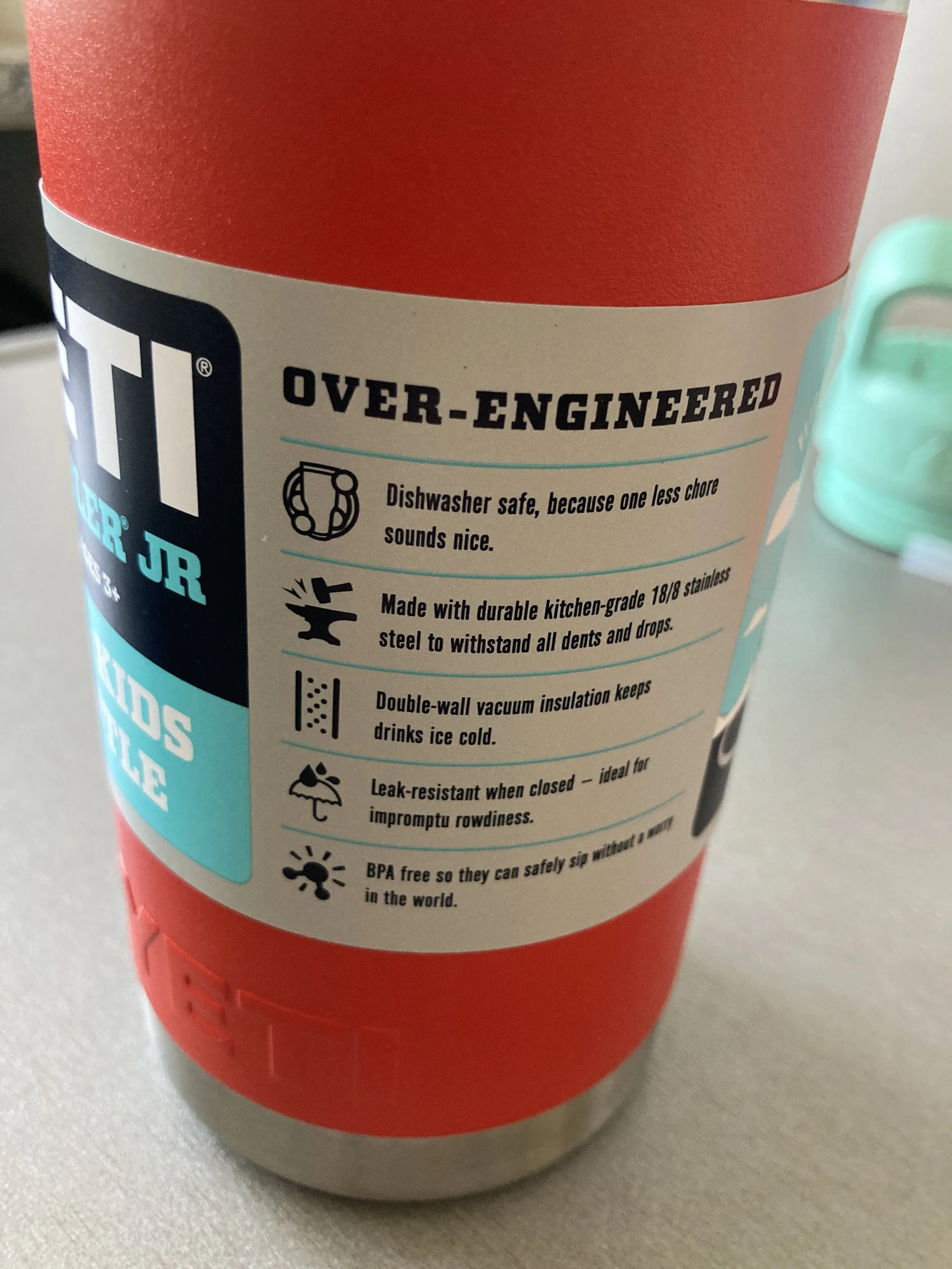Yeti water bottles: an example of speaking to your audience
One of the million challenges I’ve faced since becoming a parent is how to keep small children hydrated. Whether they’re busy playing at home, off at school, or under our supervision on a family trip, my wife and I are very conscious of the effects of the hot Mediterranean climate. We always make sure the kids have their personal, reusable water bottles close at hand.
We’ve gone through a lot of these bottles over the years. Some turned out to be too small, some were a little too fiddly to handle quick refills on the go. Some were easier to open—easy enough that the kids figured it out and had themselves a nice water fight. Some just weren’t weren’t built to hold up under a kid’s clumsy handling and tendency to drop things.
All of which is why I was so struck by our most recent water bottle purchases.
Whoever wrote this copy has got to be a parent. At the very least, they did some serious market research. Just look at that list of features – tell me that this company isn’t channeling my thoughts straight out of my head. In just a few lines, they address convenience. They address safety concerns. They address durability. And they do it all in language that speaks directly to parents.
I don’t know that I’ve ever felt as seen and catered to as I did when reading this label. Based on the way they present themselves, I believe that this brand truly understands what I’m looking for in a product. Because of that, when they tell me that they can meet my needs, I trust their judgment.
So far, they’ve delivered. We’ve been using the bottles for several months now, and I have zero complaints.
Why parents?
When you get down to it, the company’s claims are twofold: First, that their bottles are resilient. Second, that they’re safe.
The interesting thing is, these are qualities that benefit most people – not just children, but hikers and athletes and people with limited mobility. In reality, there are a lot of different audiences this brand could have chosen to market themselves to. It didn’t have to be parents.
So, why did they choose parents?
If everyone wants a bottle like this, why didn’t the company try to advertise to… well, everyone?
Applying the metaphor
This is a question that gets asked a lot in the nonprofit world. When I advise organizations to focus on a specific audience, many of them are uneasy.
“It’s hard enough to attract attention already. We have to take advantage of every opportunity. We can’t afford to cut anybody out. The bigger the pool we’re drawing from, the better.”
When I saw the water bottle copy, it immediately reminded me of all the conversations I’ve had about this issue. It also seems to me that this example is a great way to make the reasoning clear.
Let’s start with a simple question. If the company tried to appeal to everyone at once, what would that look like? How would they go about it?
If the goal were to avoid alienating anyone, they couldn’t highlight experiences that are only relevant for a specific target demographic, like wild children or adventurous hikes. Instead, they’d have to keep their language vague and broadly relevant to as many people as possible.
“Durable water bottle,” the copy might say.
But “durable” is boring. It’s true – and a great feature – but it doesn’t spark the imagination. It has no emotions or associations attached. It doesn’t inspire anyone to think, “This was made for me.”
The problem with marketing yourself to everyone is that really, in the end, it comes to about the same thing as marketing yourself to no one.
Final thoughts
Actually, there’s a caveat attached to this concept. The real problem is trying to speak to too many audiences at the same time. There’s nothing stopping a company from making one campaign for parents and another for hikers, connecting separately with each demographic. If you have limited resources, I recommend doing your research and giving priority to the demographic with the biggest potential return.
Incidentally, choosing a target audience can also be a source of inspiration inside your organization.
In the case of the water bottle company, there may not be a huge difference between the different bottles they carry – at first. The kids’ bottle and the hikers’ bottle probably have most of the same features, they’re just framed a little differently in the ad copy.
But once they choose to focus on designing for kids, this can continue to shape further product development – more safety features, innovations in how the bottle opens and closes, etc.
For a nonprofit, putting the spotlight on a particular aspect of your work can encourage you to think about how you can improve in that area, what needs are out there and how you can make an effort to meet them.
What audience is currently your biggest source of support? Have you taken steps to tailor your language and outreach to them? Why or why not? Feel free to let me know in the comments!
If you could use some help identifying the right demographic, you can also check out my strategy and messaging services: fundraising here and recruiting here.

